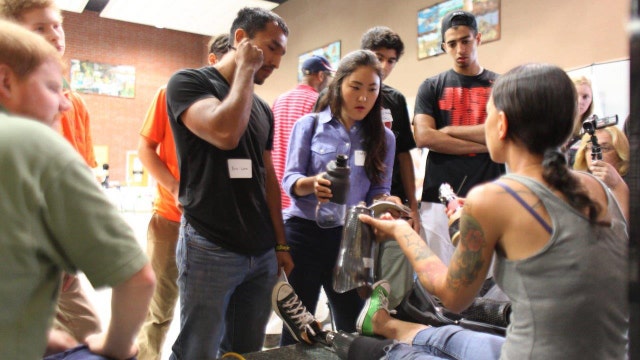One Woman, One Leg, And a Mission to Change Prosthetics
Lisa Marie Wiley, a former Army Sergeant is one of an increasing number of female veterans who are coming back injured from battle.
“I stepped on a bomb on Thanksgiving 2011,” she says. “The ground was peppered with IEDs (improvised explosive devices) and we went down on an incline and I stepped right on it.”
Wiley lost her left leg on that day, and she and other women accounted for nearly 2% of the 13,000 battle-related military casualties involving traumatic injuries to extremities in Iraq and Afghanistan from 2003 to 2013, according to the Extremity Trauma and Amputation Center of Excellence.
While that number is still low, more and more women in combat are coming back injured. The report also says that 6% of female service members suffered injuries in non-battle situations as well.
“[The] changing roles of women, both military and civilian, put females at an increased risk for traumatic extremity injury and amputation. While fewer women than men undergo amputation, women with extremity trauma and amputation have unique needs," says Andrea Ippolito, Innovators Network Lead for the Veteran Affairs Center for Innovation.
Wiley says the hardest part of her recovery was finding other amputees that she could relate too.
“When I went through recovery there were two other females and 300 guys,” says Wiley. “It’s kind of lonely sitting in a support group and I would want to talk about my problems but it’s the guys that keep pushing me out but it’s not by any fault of their own,” she says.
While vanity issues are different for everyone, Wiley says hers were simple things that others take for granted every day.
“It’s not the same wearing dresses or wearing shoes. It’s not the same taking your hair down or having a weekend to yourself because you’re always catering to a disability,” she adds.
But the vision of her wedding day pushed her to find help. And, that’s how she met Shelley Zalis, the Founder of The Girls’ Lounge, a networking group for corporate women. The organization teamed up with the Veteran’s Affairs to help drive innovation among the public and private businesses to help benefit former members of the armed forces.
“Most women with prosthetics suffer severe depression because they don’t feel beautiful so we created a whole concept around prosthetics that are beautiful,” says Zalis.
The Girls’ Lounge hosted an exhibit to create a way to personalize prosthetics, particularly for woman.
Dara Dotz, one of the designers who helped design a new cover for Wiley’s wedding day says it was all possible because of 3D printing.
“What’s really exciting about doing this is—not just for Lisa on her wedding day, but it’s also about allowing each amputee to do their own customization so it’s an extension of their personality—almost like a tattoo instead of opposing someone else’s ideas on what they think is cute for a much lower cost,” says Dotz.
The cost is now under $20 instead of costing upwards to $5,000 and it’s available to anyone who has access to a 3D printer.
Wiley says the new prosthetics covers and the experience has changed her life and more importantly, it's a huge game changer for amputees of all shapes and sizes.
“This is soon going to be a situation where it’s not just legs—it’s going to be arms and it’s not going to be just for adults, we want to help children, too,” says Wiley.




















